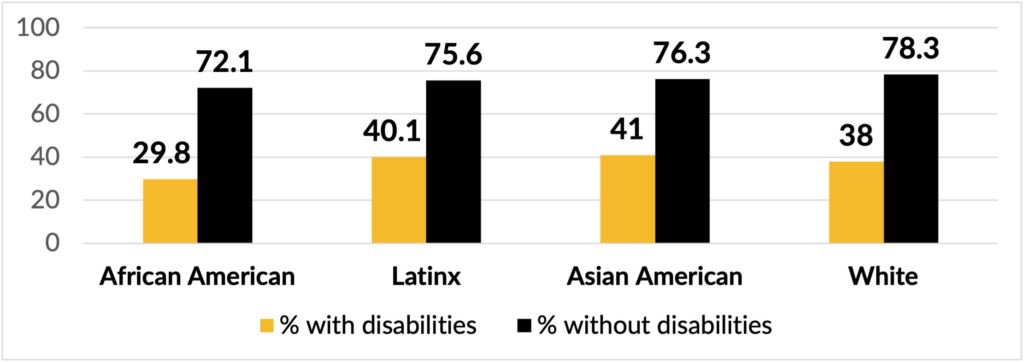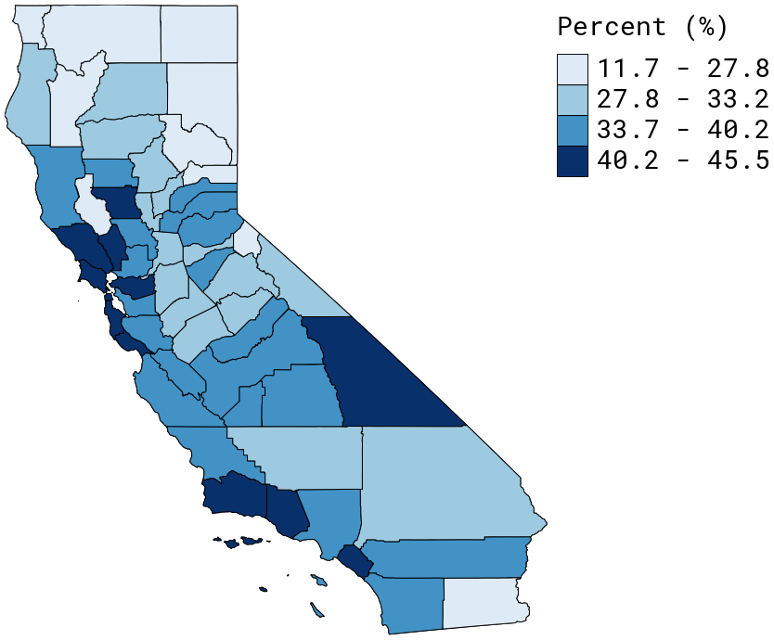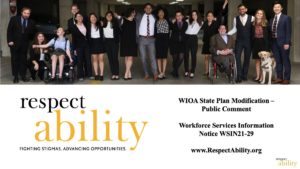Sacramento, CA, February 14 – How will the great state of California invest millions of federal and state dollars in support of jobseekers across the state? This is the central question at stake as the California Workforce Development Board publicly discusses further changes to the state’s California’s Unified Strategic Workforce Development Plan (State Plan) 2020-2023 Modification. In response, and in collaboration with partner organizations across the state, RespectAbility, a national, nonpartisan nonprofit organization, submitted testimony on how to implement best practices, advocate for greater inclusion and improve the standing of people with disabilities in the workforce.
“When it was passed with broad, bipartisan support in 2014, the Workforce Innovation and Opportunity Act (WIOA) invested unprecedented resources into efforts to get people with barriers to employment into the labor force,” said Olegario “Ollie” Cantos VII, RespectAbility’s Chairman. “Now, after the pandemic that has reshaped our economy, it is time to devote significant attention to supporting the economic advancement of students, job-seekers, and entrepreneurs with disabilities. We are glad to see the California board’s efforts to solicit public feedback and we are eager to collaborate on effective solutions for jobseekers with significant barriers to employment.”
There are more than 1.9 million working age (18-64) Californians living with some form of disability. Before the pandemic, 38.2 percent of the working age population of people with disabilities were employed. It is critical that California’s state workforce board listen to the individuals with disabilities and advocates impacted by these unemployment rates. In order to make the workforce more inclusive, and to find practical ways to make the workforce more accessible for the entire population, RespectAbility collects, summarizes, and publicizes ideas on key workforce solutions. To learn more about RespectAbility’s advocacy work, please visit our Policy website.
RespectAbility’s full testimony is presented online and below:
To: Members and Staff, California Workforce Development Board (CWDB)
From: Staff, Board, and Fellows of RespectAbility
Re: Public Comments on State WIOA Plan Modifications
Dear Chair Farooq, Ph.D. and Executive Director Rainey,
There are more than 1.9 million working age (18-64) Californians living with some form of disability. Before the pandemic, 38.2 percent of the working age population of people with disabilities (PWDs) were employed. It is critical that California’s Workforce Development Board listen to the individuals with disabilities and advocates impacted by continuing gaps in employment rates. RespectAbility is encouraged by the Workforce Board of California including important factors of employment into its modifications, particularly the labor force participation rate. RespectAbility is also encouraged by awareness of the need to work with the California Department of Rehabilitation (CDOR) to address the needs of people with disabilities.
It is commendable that the workforce board has taken an inclusive step by including services that impact people with disabilities. After examining both the United Workforce Development Plan and Vocational Rehabilitation Services Program and Supplement for the Supported Employment Services modification plan, RespectAbility believes that further changes are needed to make the workforce completely responsive to the needs of working-age people with disabilities.
Currently, California admirably serves people with disabilities in a way that will maximize success for the greatest number of people. We are concerned, however, that the State Plan indicates an intention, outlined on page 97 of the Title IV section, in FY2022-2023 to implement an “Order of Selection.” RespectAbility works in all 50 states, and we have routinely seen that these Orders of Selection result in worse employment outcomes for PWDs, an issue that we have shared with this board consistently since 2016. While it is appealing that we would devote more resources to those with greater needs, the fact that more work needs to be done for society to have a solution for employing these individuals means that there is a vast devotion of resources towards uncertain outcomes. The current model effectively serves the larger pool of consumers eligible for DOR services.
If the state chooses to go forward with implementing a three-tiered priority system, we envision a smaller number of people served with worse outcomes. All people with disabilities, from “most significant” to “disability”, deserve whatever support California can provide. In the face of limited resources, we respectfully submit that California should default to the greatest good for the greatest number.
One-in-five Americans have a disability according to the U.S. Census Bureau. People with disabilities are America’s largest minority group and the only one that, due to accident, aging, or illness, anyone can join at any time. In California itself, there are over 4.1 million residents living with some form of disability and they make up 10.6 percent of the state’s population. In that number, it is critical to recognize the great diversity and intersectional identities of people with disabilities in California. Out of that number, there are 2,217,128 Black, Indigenous, and People of Color (BIPOC) people with disabilities. That means that 53 percent of all Californians with disabilities are also members of other marginalized communities and face barriers such as systemic racism.
These facts have wide-ranging implications for the state’s overall workforce development planning. The unique challenges facing Californians with disabilities need to be recognized across the entire scope of CWDB’s work.
Labor Force Participation Rates for People with Disabilities
In the Workforce Board of California United Strategic Workforce Development Plan, people with disabilities are not mentioned until page 77. Even though this is an improvement from previous California Workforce Development Plans, where the only substantive discussion of disability issues was in an appendix covering Title IV of WIOA, it still does not meet the real need. People with disabilities should be an integral part of the document and the execution of the plan.
When calculating job protections, people with disabilities should be mentioned as viable workforce participants throughout the sector breakdown of the different regions of California. RespectAbility has also learned that the best way to ensure appropriate impacts for marginalized populations is to ensure that their outcomes, especially key outcomes like the labor force participation rate, are expressly measured and compared. Simply put, what gets measured gets done. We therefore respectfully suggest that populations, including those of people with disabilities, be specifically discussed in metrics for success as they relate to the general population. To emphasis this point, please see the data table below, which shows the current gap in employment rates between people with and without disabilities disaggregated by race.

Modification to the Vocational Rehabilitation Services Program and Supplement for the Supported Employment Services Program State Plan
Page 7 of the Rehabilitation Services Program and Supplement for the Supported Employment Services plan states, “CDOR has entered into demographic data sharing agreements with the EDD and nationally with VR agencies. The CDOR is contracting with San Diego State University to analyze consumer demographic data and employment outcomes. The CDOR’s support of these data endeavors and diversity, equity, and inclusion efforts will further the department’s commitment to the pursuit of employment, independence, and social equity.” RespectAbility applauds these efforts as the first crucial step to true collaboration between agencies. As data sharing agreements occur, the shared information will help the state develop.
Providers working with youth with and without disabilities need to be prepared to continue to provide virtual services now and in the future. As such, it is worth highlight the adaptability and innovative work done in other states around the provision of virtual pre-employment transition services (pre-ETS). We have highlighted the work of Iowa Vocational Rehabilitation Services previously in these comments, but it is also worth spotlighting the work done in Tennessee. Last year, the Tennessee Department of Human Services published a comprehensive guide about virtual pre-ETS and best practices proven during the worst months of the pandemic. Youth with disabilities need to be prepared for the digital workforce, and virtual training is a necessary first step. Continuing to provide virtual services presents a direct opportunity to tackle the digital divide by directly providing access to technology and assistive technology for youth with disabilities from marginalized communities.
Adopting a State-wide Common Application Form to Connect Jobseekers with and Without Disabilities to Workforce Services
The economic challenges and massive job losses seen across the country last year brought much-needed attention to gaps in existing labor systems. One such gap is in how people in need of support access and navigate workforce services. CalJobs has done much to encourage coordinated access to services, but there is still a need for having a single, common, and accessible state-wide application form to access workforce services. Other states and localities have successfully experimented with a common form to access everything from pre-employment transition services, to apprenticeships, to other credentialing programs. The best example of this type of approach is the No Wrong Door (NWD) System initiative previously conducted by the Administration for Community Living (ACL). While ACL’s work on creating a “No-Wrong-Door” system was specifically done around long-term services and support (LTSS) for older Americans and people with disabilities, this approach can significantly streamline bureaucratic processes, improve services, and support participant success.
Differences in Employment Outcomes by Geography among Californians with Disabilities
After an initial drop in employment thanks to the COVID-19 pandemic, the increase in telework and availability of digital tools seem to be incrementally improving employment opportunities for people with disabilities. The gap in labor force participation rates is still significant when comparing nondisabled adults versus adults with disabilities in terms of employment. As such, we are ecstatic to see the labor force participation rate be the subject of discussion on page 42 of the Economic and Workforce Analysis-WIOA 2020-2023 State plan. Given that your board has responsibility for the entire Golden State, we think that it is important to note the variations throughout the state and to encourage intrastate and regional collaboration. The county with the highest employment rate for working-aged people with disabilities is San Mateo at 45 percent. The county with the lowest employment rate for working-aged people with disabilities is Modoc County at 11.7 percent. The most populous county, Los Angeles, home to over 450,000 working-age Angelenos with disabilities, tracks with the national average with an employment rate of 36.3 percent pre-COVID.
Here is a map delineating difference in employment rates among Californians with disabilities on a county-by-county basis.

Mentioning the labor force participation rate in your report on page 42 is a terrific way to make sure you are focusing on the most important metric that truly impacts employment of people with disabilities. Since employment outcomes are broadly still dismal for individuals with disabilities throughout the state, we need to work on creative solutions including cross-sector collaboration and creating talent pipelines.
There is a clear need to prepare people with disabilities before entering the labor market. The turning point for learning and training is in the transitional phase of students with disabilities leaving the educational system. Traditionally in the school system, people with disabilities are matriculated into the next grade without ensuring their ability to read, write, and understand basic math skills. Often people with disabilities who cannot pass basic skill assessments are given a diploma of attendance upon graduation without ascertaining capabilities of entering the workforce. On page 38 and 39 of the Vocational Rehabilitation Services Program and Supplement for the Supported Employment Services modification plan, Individualized Education Plan (IEP) and the Individualized Plan of Employment (IPE) are brought together to ensure that transition services for students with disabilities receive the educational supports which include course of study to improve their skills and transition services into the workforce are part of a student’s transitional plan. Pivoting now, it is worth looking at how local community colleges are the true hidden gems of the educational system and are uniquely suited to meet the needs of students with disabilities.
Improving the Workforce Impact of Community Colleges and Helping Students with Disabilities to Succeed
Community colleges are crucial pieces of the nation’s workforce development infrastructure. In many states, community colleges help direct the investment of WIOA dollars in programs or agencies. State and local Workforce Investment Boards can build sector partnerships that leverage community colleges and other education and training providers to develop career pathways that align workforce supply and demand. WIOA emphasizes the value of recognized postsecondary credentials. The attention given to career pathways in the act provides a way for community colleges to contribute to the growth of skilled and credentialed workers in their local areas. Community colleges in California received state funding for Disabled Student Programs and Services (DSPS) to assist in providing support services and educational accommodations to students with disabilities so they can have full and equitable access to the community college experience. Part of the community college experience can include job training and readiness. The Rehabilitation Act of 1973, as amended by WIOA, emphasizes the provision of services to students and youth with disabilities to ensure they have opportunities to receive the training and other services necessary to achieve competitive integrated employment. It also expands the population of students with disabilities who may receive services, and the kinds of services that the VR agencies may provide to youth and students with disabilities who are transitioning from school to postsecondary education and employment. Making a connection with Disabled Student Programs across every state with WIOA Eligible Training Provider programs at community colleges creates a pipeline of trained and/or certified workers with disabilities ready for the local competitive integrated job market.
Preparing youth and people with disabilities for the workforce of California is essential for their success in life. There is a great focus on having interagency agreements and memorandum of understanding (MOU) between different agencies and local education agencies (LEAs) in the Vocational Rehabilitation Services Program and Supplement for the Supported Employment Services modification plan, but the integration of the business needs/sector is not mentioned until page 111. School-based assessment is crucial to workforce preparation but without prioritizing business needs, individuals with disabilities will not be prepared for the job demands of different industries. The two main goals discussed on page 111 are as follows:
- Meet business talent needs by preparing consumers for in-demand jobs using local and regional labor market information.
- Build a direct pathway between employers and workers with disabilities, including developing innovative ways to engage businesses.
Given the tremendous demand for workers in the labor force and the increasing labor force participation rates among working-age people with disabilities, now is an ideal moment for workforce development leaders to reach out to private sector partners about disability employment best practices. First up, employers should be aware of and capitalize on the value of the Work Opportunity Tax Credit (WOTC) and Disabled Access Credit offered by the federal government. More details about the value and impact of those tax credits are available through the U.S. Department of Labor.
Learning from Private Sector Innovators
Likewise, private sector employers need to look at the successful inclusion practices of companies like JP Morgan Chase, Coca-Cola, UPS, EY, IBM, Walgreens, Starbucks, and SAP. Each of these employers are case studies that show people with disabilities can succeed. Accenture completed a major study that shows that such companies have seen “28 percent higher revenue, double the net income, and 30 percent higher economic profit margins” over a four-year period. That’s because people with disabilities bring unique characteristics and talents to the workplace that benefit employers and organizations. If we find the right jobs for the right people, it can and will increase the bottom line of companies.
Given the unprecedented situation created by the COVID-19 pandemic and economic crisis, new ideas, new efforts, and new leadership are needed to make the post-pandemic economy more inclusive for all. Our community has been hit hard by the pandemic, and it needs to be at the forefront of any recovery efforts.
Capitalizing on Best Practices around Inclusive Apprenticeships, Subsidized Employment and On-The-Job-Training for Workers with Disabilities
Expanding post-secondary training programs and industry recognized credentials has been a signature goal of the past 6 years under the Workforce Innovation and Opportunity Act (WIOA) of 2014. There are now more apprenticeships than ever before, more subsidized employment programs, and more options for workers to “earn while they learn.” Additionally, there is now a body of proven or emerging best practices when it comes to promoting inclusion for workers with disabilities through apprenticeship programs. Over the past several years, the U.S. Department of Labor’s Office of Disability Employment Policy has documented great success through the Apprenticeship Inclusion Models (AIM). Completed in partnership with industry leaders like Amazon and Microsoft, this model generated real world data and experience on using apprenticeship programs to create a credentialing pipeline for workers with disabilities. Likewise, projects in diverse states such as Wisconsin, Pennsylvania, New Jersey, Ohio, Michigan and Virginia have proven strategies for expanding inclusive apprenticeships.
In particular, English-language learners with disabilities represent untapped potential for the workforce. The DOR modified plan does not really take into consideration the need for a special focus on English-language learners with disabilities. There are translators, and documents that are translated into several languages as part of their services. But the question lies in the educational attainment of people with disabilities who are English-language learners. There is no accountability for skill attainment and proficiency with the checks and balances within the Vocational Rehabilitation Services Program and Supplement for the Supported Employment Services modification plan. A special section should be dedicated to English-language learners in their transitional services in acquiring proficiency in English writing and reading before entering California’s workforce. As documented by the Los Angeles Times earlier last year, more than 20 percent of students in the Los Angeles Unified School District are English-language Learners. At a total of over 120,000 students, this represents a critical population among the students supported by one of the nation’s largest school systems. Fully 46.6 percent of LAUSD students with disabilities have Limited English Proficiency (LEP). Meeting the educational needs and employment aspirations of these students and other such students in other California communities will require closer cooperation between workforce programs and local educational authorities. This needs to include, but is not limited to, resources available to non-English speakers, family engagement strategies, local plans, and teacher training around these intersectional issues.
As an organization that advocates on behalf of job seekers with disabilities and their families, we believe that collecting the best ideas, emerging practices and innovative policies is critical to ensuring that Americans with and without disabilities have equal access to good jobs. Without such ideas communities and policymakers cannot direct appropriate resources to the places that need them most. If you have any questions or would like to discuss these matters further, our team stands ready to help, however we can.
These comments were prepared by RespectAbility’s Apprentices, Staff, and Board Members. Special credit is due to Nelly Nieblas, our Manager of Policy, Advocacy and Engagement, charged with leading our critical workforce development efforts in California.


Be First to Comment